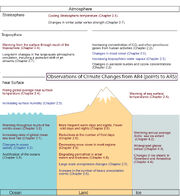There are many indicators of climate change. These include physical responses such as changes in the following: surface temperature, atmospheric water vapour, precipitation, severe events, glaciers, ocean and land ice, and sea level. Some key examples of such changes in important climate parameters are discussed in this section and all are assessed in much more detail in other chapters.
As was done to a more limited extent in AR4 (Le Treut et al., 2007)[1], this section provides a test of the planetary-scale hypotheses of climate change against observations. In other words, how well do the projections used in the past assessments compare with observations to date? Seven additional years of observations are now available to evaluate earlier model projections. The projected range that was given in each assessment is compared to observations. The largest possible range of scenarios available for a specific variable for each of the previous assessment reports is shown in the figures.

Figure 1.3 Overview of observed climate change indicators as listed in AR4. Chapter numbers indicate where detailed discussions for these indicators are found in AR5 (temperature: red; hydrological: blue; others: black).
Based on the assessment of AR4, a number of the key climate and associated environmental parameters are presented in Figure 1.3, which updates the similar figure in the Technical Summary (TS) of IPCC (2001). This section discusses the recent changes in several indicators, while more thorough assessments for each of these indicators are provided in other chapters. Also shown in parentheses in Figure 1.3 are the chapter and section where those indicators of change are assessed in AR5.
Note that projections presented in the IPCC assessments are not predictions (see the Glossary in Annex III); the analyses in the discussion below only examine the short-term plausibility of the projections up to AR4, including the scenarios for future emissions and the models used to simulate these scenarios in the earlier assessments. Model results from the Coupled Model Intercomparison Project Phase 5 (CMIP5) (Taylor et al., 2012)[2] used in AR5 are therefore not included in this section; Chapters 11 and 12 describe the projections from the new modelling studies. Note that none of the scenarios examined in the IPCC assessments were ever intended to be short-term predictors of change.
Notes[]
- ↑ Le Treut, H., R. Somerville, U. Cubasch, Y. Ding, C. Mauritzen, A. Mokssit, T. Peterson and M. Prather, 2007: Historical Overview of Climate Change. In: Climate Change 2007: The Physical Science Basis. Contribution of Working Group I to the Fourth Assessment Report of the Intergovernmental Panel on Climate Change [Solomon, S., D. Qin, M. Manning, Z. Chen, M. Marquis, K.B. Averyt, M. Tignor and H.L. Miller (eds.)]. Cambridge University Press, Cambridge, United Kingdom and New York, NY, USA.
- ↑ Taylor, K. E., R. J. Stouffer, and G. A. Meehl, 2012: An overview of CMIP5 and the experiment design. Bull. Am. Meteorol. Soc., 93, 485–498.
ES 1.1 1.2.1 1.2.2 1.2.3 1.3 1.3.1 1.3.2 1.3.3 1.3.4 1.3.4.1 1.3.4.2 1.3.4.3 1.4.1 1.4.2 1.4.3 1.4.4 1.5 1.5.1 1.5.2 1.6 Box 1 FAQ Refs